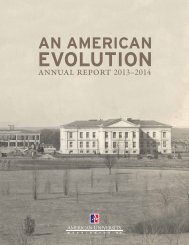American Magazine: November 2016
In this issue, delve into the Scandal-ous life of Judy Smith, meet ESPN’s new public editor, reflect on a decade of transformation under President Neil Kerwin, and learn more about autism—the fastest growing developmental disorder in the United States. Hop on the Metro to Capitol South and get to know a few of AU’s 1,068 Seattle transplants.
In this issue, delve into the Scandal-ous life of Judy Smith, meet ESPN’s new public editor, reflect on a decade of transformation under President Neil Kerwin, and learn more about autism—the fastest growing developmental disorder in the United States. Hop on the Metro to Capitol South and get to know a few of AU’s 1,068 Seattle transplants.
You also want an ePaper? Increase the reach of your titles
YUMPU automatically turns print PDFs into web optimized ePapers that Google loves.
escalators or ceiling fans, for example—and<br />
have difficulty sleeping and eating. Although<br />
40 percent of those with ASD have average<br />
to above-average intelligence and some are<br />
gifted mathematicians or musicians, Dustin<br />
Hoffman’s autistic savant in the 1988 movie<br />
Rain Man is the exception, not the rule.<br />
“The neural story for autism is<br />
extraordinarily complex,” says psychology<br />
professor Catherine Stoodley, principal<br />
investigator for AU’s Developmental<br />
Neuroscience Lab. “More differences exist<br />
between autistic brains than between<br />
[neurotypical] ones.” However, the<br />
cerebellum—located at the base of the brain<br />
and home to half of its neurons—shows<br />
remarkably consistent signs of abnormality<br />
among those on the spectrum.<br />
The cerebellum plays an important role in<br />
motor control, movement-related functions,<br />
and cognitive functions, including social<br />
cognition and language—which is the focus<br />
of Stoodley’s research, funded by a three-year<br />
grant from the National Institutes of Health.<br />
“The goal is to better understand how the<br />
[autistic] brain is working so we can capitalize<br />
on strengths and improve the parts that aren’t<br />
functioning as well,” Stoodley says. But “there<br />
are no easy answers, no quick answers,” given<br />
autism’s broad spectrum. “If you look at the<br />
population we’re studying, IQs might range<br />
from 120 down to 70 or lower. Behaviors<br />
are so different and so complex, they can be<br />
difficult to unravel.”<br />
Debate over autism’s growing prevalence<br />
is akin to the chicken-and-egg argument.<br />
Many believe that a broader definition of<br />
ASD and more finely-tuned diagnostic efforts<br />
have helped to identify more people on the<br />
spectrum. However, as the CDC states on its<br />
website, “a true increase in the number of<br />
people with ASD cannot be ruled out.”<br />
There is no cure and no known cause,<br />
although DNA plays a big role. Nongenetic<br />
or environmental factors that influence<br />
early brain development don’t cause ASD by<br />
themselves, but they can increase a child’s<br />
risk of autism. Advanced parental age is a risk<br />
factor, as are prematurity and low birth weight.<br />
Kids are often diagnosed with autism<br />
at three or four years old, which is around<br />
the same time they receive immunizations.<br />
But correlation is not causation. “At Autism<br />
Speaks, we still receive questions regarding<br />
vaccines, but as an organization dedicated<br />
first and foremost to science and research,<br />
we go off of the research, which clearly shows<br />
vaccines don’t cause autism,” says Marley<br />
Rave, SPA/MPA ’13, national director of major<br />
giving at the nonprofit’s DC office. The CDC<br />
and World Health Organization have also<br />
dismissed any causal relationship between<br />
immunizations and ASD.<br />
Wandering is a major safety concern within<br />
the ASD community. According to Rave, 50<br />
percent of kids with ASD (my son included)<br />
wander, bolt, or elope—a rate nearly four<br />
times that of neurotypical youngsters. More<br />
than one-third of children with ASD are never<br />
or rarely able to communicate their name,<br />
address, or phone number, according to the<br />
National Autism Association. Many are fearful<br />
of police and emergency workers, who often<br />
lack the training to effectively identify and<br />
communicate with people on the spectrum.<br />
We saw this play out (literally, on cell phone<br />
video) in North Miami, Florida, in July, when<br />
police shot a behavioral therapist who was<br />
trying to calm his 27-year-old autistic client.<br />
The young man had wandered from his<br />
assisted living facility and was sitting in the<br />
middle of the street, clutching a toy truck, and<br />
screaming at his therapist to “shut up,” which<br />
officers took as a threat. Police admitted they<br />
made a mistake by shooting the therapist—they<br />
were aiming for the autistic man.<br />
“If your child was just diagnosed, you<br />
might need some time to get used to the idea.<br />
Take a few days. Cry, moan, scream, bitch,<br />
blame your spouse’s family—do whatever you<br />
need to for a little while. A very little while.<br />
Then roll up your sleeves and get to work.”<br />
When I got to this line in Lynn Kern Koegel<br />
and Claire LaZebnik’s Overcoming Autism, I<br />
laughed out loud. Just a few nights before, Sam<br />
and I had angrily shaken the branches of one<br />
another’s family trees. It was a relief to know<br />
the need to point fingers is completely normal.<br />
Autism had inserted itself into our lives<br />
overnight. It was surreal, discombobulating,<br />
and exhausting. It was all we could talk about,<br />
all I could think about. On particularly bad<br />
days, I would slip into the bathroom at work<br />
for a quick cry. I have always looked at my<br />
child and thought: He will be successful, he<br />
will love and be loved, he will be happy. Those<br />
three letters—A-S-D—rocked my foundation.<br />
Fall 2015 was a whirlwind of appointments.<br />
In addition to seeing doctors through our<br />
insurance provider, Owen was evaluated by<br />
Child Find and referred to Developmental<br />
Education Services for Children (DESC) in<br />
Montgomery County, Maryland, where we live.<br />
The process was incredibly illuminating. We<br />
learned that Owen has sensory processing issues<br />
(he gets overwhelmed and anxious in a loud<br />
restaurant or in a chaotic classroom) and poor<br />
gross and fine motor skills, which is common<br />
among kids with ASD. We also discovered that<br />
Owen’s severe gastrointestinal problems, which<br />
began plaguing him at three months old, were<br />
probably the earliest sign of autism.<br />
The DESC evaluation gave us our first<br />
real glimpse of Owen’s days at school. “Owen<br />
sometimes stopped playing and looked lost<br />
in thought as he played with the fringe on his<br />
blanket,” the psychologist wrote.<br />
My heart ached. But when the official<br />
diagnosis of ASD came on October 22, 2015,<br />
there were no tears—there was only relief and<br />
an overwhelming sense of determination to do<br />
everything in my power to help my son. “This<br />
is the low point,” the doctor told Sam and me.<br />
“It will only get better from here.”<br />
When Tracey Staley, Kogod/BSBA ’84,<br />
learned of her son Jeff’s diagnosis in 2000,<br />
her first thought was: what’s Asperger’s?<br />
Staley was working at a tech company at<br />
the time of six-year-old Jeff’s diagnosis and<br />
began reading up on Asperger’s, a highfunctioning<br />
form of autism first identified by<br />
Austrian pediatrician Hans Asperger in 1944.<br />
“I realized, ‘Hey, I know a lot of people like<br />
this,’” she says. “There was a sense of relief<br />
that we finally knew what was going on.”<br />
A gifted little boy who loved trains, Jeff<br />
developed normally, but Staley and her husband<br />
Mike noticed that he would get overwhelmed by<br />
loud noises. Once in first grade, Jeff disappeared<br />
from the cafeteria; panicked teachers later<br />
found him in the classroom, enjoying his lunch<br />
in blissful silence.<br />
Jeff’s tendency to be literal attracted<br />
bullies who teased him about “ants in the<br />
pants” or, worse yet, “liar, liar, pants on<br />
fire.” (According to the National Autism<br />
Association, 65 percent of autistic kids are<br />
bullied by their peers.) Eventually, things<br />
began to even out when Jeff, who was also<br />
diagnosed with Attention Deficit Disorder<br />
(ADD), enrolled in a program for Asperger’s<br />
students in third grade.<br />
Good teachers and a principal who “got<br />
it” made all the difference, as did the right<br />
20 AMERICAN MAGAZINE NOVEMBER <strong>2016</strong>

















